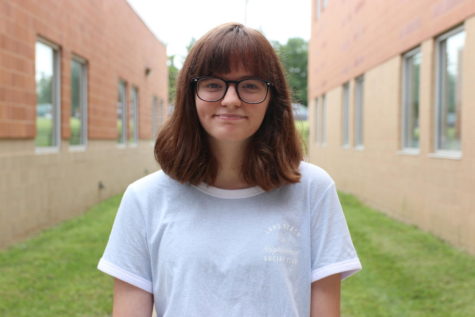RSD Offers Quit Kits to Students in Need of Vaping Recovery
Media by Lili Schliesser
Quit Kits put together by Lili Schliesser contain information for someone who is quitting, information for anyone supporting them and some inconspicuous tools to deal with cravings including packs of mint gum, cinnamon toothpicks and chapstick.
RSD is no stranger to the use of vaping products throughout its schools, with vaping being the number one substance in RSD schools, according to the Rockwood Drug-Free Coalition.
Data from a RSD survey in 2018 reported 27.3 percent of students using vapes at MHS in the 30-day period leading up to that survey.
Lili Schliesser, project coordinator of the Rockwood Drug-Free Coalition, said the number is more likely about 40-50 percent due to the national increases in the past two years.
In 2017, it was reported by Truth Initiative that 11 percent of high school students had used an e-cigarette in the last 30 days. By 2019, Truth Initiative updated that the number had increased to 27.5 percent.
Schliesser said some students reported obtaining their vaping supply from students at school.
With the COVID-19 crisis causing students to go into lockdown on behalf of Missouri’s stay-at-home order that went into effect Monday, April 6, many individuals are now left going through withdrawals.
Going through withdrawals may cause symptoms such as irritability, headaches, anxiety and trouble sleeping, according to SmokeFree.
Schliesser said though withdrawal may be an uncomfortable experience, now is the perfect opportunity to attempt to quit.
“Hopefully, students see how hard it is to deal with the withdrawals from nicotine and decide to get off of them all together rather than start back up when things get back to normal,” Schliesser said.
In order to do this, students have an opportunity to obtain Quit Kits. These kits are free of charge and contain information for someone who is quitting, information for anyone supporting them and some inconspicuous tools to deal with cravings including packs of mint gum, cinnamon toothpicks and chapstick.
Schliesser puts the kits together and mails to homes. Students or parents worried about contamination should let the kit sit for three days.
Anyone can request a Quit Kit by emailing Schliesser at schliesserlili@rsdmo.org.
Within the MHS community, individuals are fighting the fight against drugs, alcohol and vaping usage in young students.
Students Against Destructive Decisions (SADD) is a club working toward educating and preventing students from engaging in ruinous behavior. SADD gathers twice a month to evaluate the problems at MHS and in the community to come up with a strategy to help.
Connor McLaughlin, senior, believes strongly in the fight against destructive decisions. McLaughlin has been a member of SADD for four years and said the use of Quit Kits during these uncertain times for students who may feel as though quitting feels impossible is an excellent first step to help students who are in need.
“Helping someone with the first step of quitting an addiction may provide a much-needed boost that they didn’t even know existed,” McLaughin said.
To McLaughlin, everyone has the right to know the facts and risks of affiliating with consequential behaviors. He said without any education about the risks, many people may have no idea what they are getting into.
In order to fight against detrimental choices, McLaughlin said going against the positive stigma vaping has would be the most effective.
“We’ve seen the teenage stigma of smoking take a turn in the past few decades, and the same can definitely happen with vaping if more students start to take the facts to heart and find healthier alternatives,” McLaughlin said.
Laura Coverstone, SADD sponsor, said being isolated from hazardous environments and peer pressure, has caused students to now have limited access to the source of their addiction. Coverstone said now could not be a better time for students to attempt to quit, and she hopes students suffering from nicotine addiction take advantage of this opportunity to change.
Covertone said the most powerful form of prevention from high-risk decisions like vaping is through storytelling and statistics.
“Peer pressure works both ways,” Coverstone said. “If students can positively pressure their classmates to stay away from destructive behavior, then they will have succeeded at not only changing lives but also saving some lives along the way.”
SADD’s main goal is to drive home the reality of destructive consequences that come from drugs, vaping or alcohol by educating students of the serious gravity behind these decisions through the use of peers.
“Since the information is coming from peers, I feel, it has the power to stop classmates in their tracks,” Coverstone said. “To challenge them to really think about the decisions ahead of them and make the right ones.”
Your donation will support the student journalists of Marquette High School. Your contribution will allow us to purchase equipment and cover our annual website hosting costs. You may become a PATRON by making a donation at one of these levels: White/$30, Green/$50, Blue/$100. Patron names will be published in the print newsmagazine, on the website and once per quarter on our social media accounts.

Molly Sillitto, junior, is the Opinions Editor for the Marquette Messenger. This will be her second year on staff. Molly likes to listen to music, go outside...







